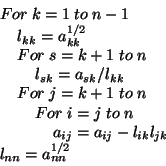



Next: Matrix multiplication with reduced
Up: Array Sections
Previous: Two-dimensional Fourier transform
Contents
If  is a symmetric positive definite matrix, associated
linear equations are often using Choleski decomposition:
is a symmetric positive definite matrix, associated
linear equations are often using Choleski decomposition:
where  is a lower triangular matrix. In practise this is
followed by forward and back substitutions:
is a lower triangular matrix. In practise this is
followed by forward and back substitutions:
to complete the solution of  .
A pseudocode algorithm for Cholesky decomposition is
.
A pseudocode algorithm for Cholesky decomposition is
A parallel version, assuming the main array is stored by columns
with the rows cyclically distributed, is given in figure 4.4.
The  array is accumulated in the lower part of the input array
a. Note that the array b has a replicated distribution, so the
remap operation is a broadcast of the relevant part of column
array is accumulated in the lower part of the input array
a. Note that the array b has a replicated distribution, so the
remap operation is a broadcast of the relevant part of column
 .
.
Figure 4.4:
Choleksy decomposition.
![\begin{figure}
\small\begin{verbatim}Procs1 p = new Procs1(P) ;
on(p) {
Ran...
... [N - 1])
a [N - 1, j] = Math.sqrt(a [N - 1, j]) ;
}\end{verbatim}\end{figure}](img47.gif) |
Bryan Carpenter
2000-05-19
![]() is a symmetric positive definite matrix, associated
linear equations are often using Choleski decomposition:
is a symmetric positive definite matrix, associated
linear equations are often using Choleski decomposition:
